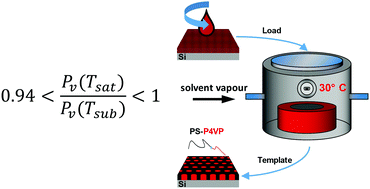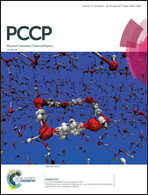Controlled solvent vapor annealing of a high χ block copolymer thin film†
Abstract
Molecular self-assembling block copolymers (BCPs) have shown promise as a next generation bottom-up lithography technology. However, a critical step in advancing this approach is the elimination of polymer dewetting due to bulk solvent nucleation and thermodynamically driven film rupture that can occur during the solvent vapor annealing process. We report on the pattern formation via phase segregation of spin coated diblock copolymer films through the investigation of annealing parameters in the limit of high solvent vapor saturation conditions that results in wafer-scale patterning without observing polymer dewetting defects. Specifically, the work addresses polymer dewetting in diblock copolymer nanodot templates through the use of a “neutral” functionalization layer and the development of a custom-built solvent vapor annealing chamber to precisely control saturation conditions. Furthermore, the long anneal times (4 h) using a standard static solvent vapor annealing procedure were reduced to ∼15–30 minutes with our dynamic solvent vapor annealing system for the high χ, cylindrical forming poly(styrene)-block-poly(4-vinyl-pyridine) [PS-b-P4VP] diblock copolymer system. We discuss the kinetic mechanism governing the phase segregation process that highlights the small processing window bounded by long phase segregation timescales (≳1 min) on one side and the initiation of polymer film dewetting on the other. These results demonstrate a key step towards realizing a high fidelity, low cost BCP patterning technique for large-scale “bottom-up” feature definition at nanometer length scales.



 Please wait while we load your content...
Please wait while we load your content...